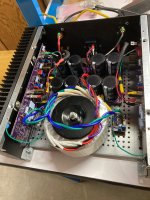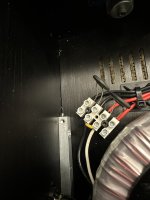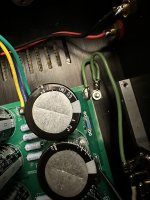Hello, a couple of weeks ago I was on this site trying to get some help to better understand the inner workings of this amplifier. I purchased a scope and wanted to learn how to use it. The amplifier has a hum from both speakers with nothing connected to the inputs. I will attach some pics of the internals hoping someone can see any faults with my wiring and make some change recommendations ............also I am using a 20volt antek transformer instead of the recommended 18volt.. would appreciate any help thanks.
Attachments
It's hard to tell from the picture, but I don't see any return to mains (earth) ground. If there is a return, there needs to be a thermistor between circuit ground and mains ground. I also don't see anything that looks like a star ground point for the chassis. All of this matters. I built an Aleph 30 with hum that went away when I improved the chassis grounding scheme.
It's a little hard to see, but this is an Aleph that doesn't hum. Note the green wires from the heat sinks. They go to the star ground, which is hidden between the trafo and the PSU board on the base plate. There are four things connected to the star ground- the purple shield wire from the trafo, the two green wires from the heat sinks, and the circuit ground on the PSU board, after the thermistor.
Attachments
the green wire goes from the IEC socket to the board and if you look closely there is a thermistor
Have you rotated the transformer to see if the hum reduces? There's typically a null point where the hum is lowest.
Hello, no I haven't tried to move the transformer but I will added to the list of fix possibilities. I am using a 20volt transformer instead of the 18volt. Would that make a difference?
The cap board is attached to the bottom plate with some stand offs but the ground that goes around the entire board is connected to th 4 screws . there is a ground at each stand off. Would that be ground loop?
20V donut will get you higher rail voltage, but it won't be the reason for hum.
Here is some good reading on this topic.
https://hifisonix.com/wp-content/uploads/2019/02/Ground-Loops.pdf
Hum in an AJ clone I bought is what got me to join DIYAudio. Jim 6L6 pointed me to this link.
Have a read of that link.
Loosen the bolt and slowly rotate the donut - see if that makes a difference.
Wire routing and twisting is important, too. I found that what seems like a tiny movement of wires can make a big difference. The hard part can be finding which wire(s) and where the right placement is.
Here is some good reading on this topic.
https://hifisonix.com/wp-content/uploads/2019/02/Ground-Loops.pdf
Hum in an AJ clone I bought is what got me to join DIYAudio. Jim 6L6 pointed me to this link.
Have a read of that link.
Loosen the bolt and slowly rotate the donut - see if that makes a difference.
Wire routing and twisting is important, too. I found that what seems like a tiny movement of wires can make a big difference. The hard part can be finding which wire(s) and where the right placement is.
The hifisonix article by diyAudio member Bonsai has very good information. I learned a lot from it.
Definitely rotate the transformer. I think 15 to 20 degrees of clockwise rotation will get to the sweet spot. From my experience with Antek transformers, the quietest position is when the input/output wire locations are aligned with the chassis centreline, so that they are the farthest away from the amplifier boards.
Another factor that affects the perception of noise is speaker sensitivity. Crooner2264, what is the sensitivity of your speakers?
Regarding the PS board standoffs, since the thermistor to ground is on the board and the path to chassis ground is via the perimeter ground trace, one standoff needs to be metal to make the electrical connection to ground.
I see that the safety ground from the IEC socket is connected to the PS board/standoff and then to chassis. The ground from the IEC socket must be connected directly to the chassis. That is a safety requirement.
Also check the signal ground. The input jack ground should not be connect to chassis ground. A resistance check between signal ground and chassis ground should show approximately 10R, the cold resistance of the thermistor.
The power supply board that is installed does not have good layout. The ground output is in a bad location, and the V+ and V- outputs are not in ideal locations either. But first address the above noted issues.
Definitely rotate the transformer. I think 15 to 20 degrees of clockwise rotation will get to the sweet spot. From my experience with Antek transformers, the quietest position is when the input/output wire locations are aligned with the chassis centreline, so that they are the farthest away from the amplifier boards.
Another factor that affects the perception of noise is speaker sensitivity. Crooner2264, what is the sensitivity of your speakers?
Regarding the PS board standoffs, since the thermistor to ground is on the board and the path to chassis ground is via the perimeter ground trace, one standoff needs to be metal to make the electrical connection to ground.
I see that the safety ground from the IEC socket is connected to the PS board/standoff and then to chassis. The ground from the IEC socket must be connected directly to the chassis. That is a safety requirement.
Also check the signal ground. The input jack ground should not be connect to chassis ground. A resistance check between signal ground and chassis ground should show approximately 10R, the cold resistance of the thermistor.
The power supply board that is installed does not have good layout. The ground output is in a bad location, and the V+ and V- outputs are not in ideal locations either. But first address the above noted issues.
I will say 90% of hum problems can be traced back to a ground issue. Star ground is what you want to do. What this means is connect all grounds, input, output, etc to one spot at the PS. If doing this you still have hum then look elsewhere, rotating transformer, and assembly errors, etc. At least the way I do it when I encounter hum on new build. There is a jumper on the input if memory is correct you may want to check if not balanced input.
Typically mains ground would go straight to the bottom plate of the chassis and would be called chassis ground. Then ground goes through a thermistor like what you have.
I suspect the chassis ground that goes to each standoff then leads to one leg of the thermistor. The PS board is picking up the chassis ground. A better solution is to use one screw to pick up ground with. Although I don't think that is your issue.
Check with a multimeter for resistance between the chassis ground and your signal ground on the RCA. It should be close to whatever the resistance of your ground thermistor is.
I suspect the chassis ground that goes to each standoff then leads to one leg of the thermistor. The PS board is picking up the chassis ground. A better solution is to use one screw to pick up ground with. Although I don't think that is your issue.
Check with a multimeter for resistance between the chassis ground and your signal ground on the RCA. It should be close to whatever the resistance of your ground thermistor is.
I think your mains termination is wrong.... check the photo I attached and ensure you wire the primary windings as per the photo - where are the two black wires marked with white Xs going??? Is that a loop?


Confirm that the resistance between two black Xs is 10 ohms (with CL60):

Your XLR wiring looks okay.
Is that buzz the same on both channels??
What happens with the buzz when you short XLR in hot and cold?
Confirm that the resistance between two black Xs is 10 ohms (with CL60):
Your XLR wiring looks okay.
Is that buzz the same on both channels??
What happens with the buzz when you short XLR in hot and cold?
Last edited:
So, the hum is still there? It looks like there is a trace completely around the perimeter of the power supply board that is connected to chassis and one end of the thermistor. If this is a complete loop, I wonder if it is acting as an antenna and picking up hum.
- Home
- Amplifiers
- Pass Labs
- Aleph J hum








